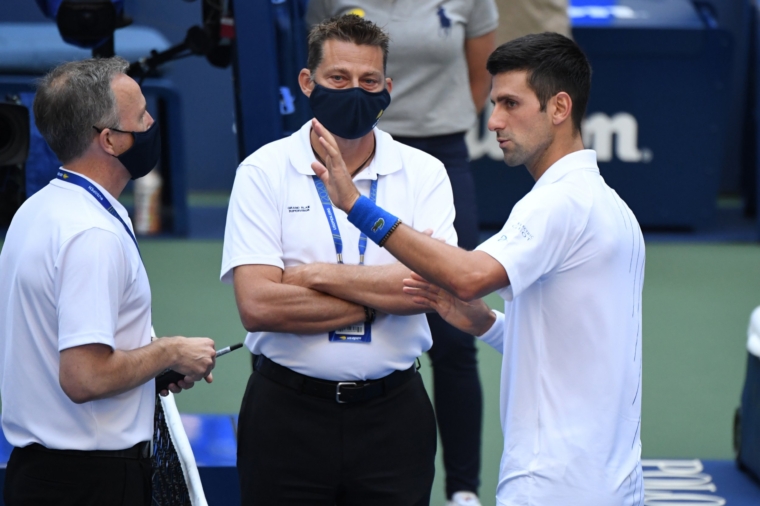Novak Djokovic was one of the shortest-price favourites ever ahead of the US Open, thanks to the absence of Roger Federer and Rafael Nadal.
The world No 1 didn’t much care that there might be an asterisk next to 2020 on his record, with this being the first ever grand slam played behind closed doors. Instead though, there is a line through it. There will be a new grand slam champion at Flushing Meadows, with Djokovic’s downfall entirely by his own hand.
No one ever really enjoys a match against Pablo Carreno Busta, the Spaniard is a difficult opponent at the best of times, but Djokovic was particularly frustrated.
Having already received treatment after falling on his shoulder, the Serbian had squandered three set points at 0-40 on the Carreno Busta serve, although in fairness his opponent had battered a forehand at 88 miles an hour, clipping the line, for one of them. Nevertheless, it was a frustrating moment and Djokovic served at 5-5 knowing he should be sitting down preparing for the second set.
Almost inevitably then, he slipped to 0-40 and lost his serve. In a moment of madness, he then grabbed a ball and hit it towards the back wall. It struck the central line judge square in the throat. He immediately raced over to check on her health.
No serious damage was done. In truth, Djokovic had not hit the ball that hard, but equally he had not lobbed it gently away for a ball person to pick up on the third bounce. It was hit with a little venom and frustration.
There was a lengthy delay, firstly to check on the health of the person Djokovic struck and then to decide what to do about the incident. It could have been a much shorter conference, because default was always the most likely outcome.
The rules
The regulations governing the US Open can be found in the ITF’s Official Grand Slam Rule Book, an 85-page document that covers everything from giving tournament officials your mobile phone number to what colour shorts are allowed in warm-up.

It has to be seen to be believed 🤯
The moment world No.1 Novak Djokovic was defaulted at the #USOpen pic.twitter.com/tSNUirmgLq
— Amazon Prime Video Sport (@primevideosport) September 7, 2020
The relevant section in this case is part Q, entitled “physical abuse”.
“Players shall not at any time physically abuse any official, opponent, spectator or other person within the precincts of the tournament site… physical abuse is the unauthorised touching of an official, opponent, spectator or other person.”
It seems pretty clear that, just as it was when Tim Henman struck a ball girl with a ball at Wimbledon in 1995 and when David Nalbandian kicked an advertising hoarding into the shin of a line judge at Queen’s in 2021, this was physical abuse.
Djokovic claimed that officials did not have to disqualify him, that they could first given him a game or a set penalty. He was referring to the point penalty schedule which is more often used for in-game offences. However, the rules also state that if the offence is “flagrant and particularly injurious to the success of a tournament or singularly egregious”, ie if it is a particularly bad incident, then they can simply disqualify the player.
Irrespective of intent, hitting a line judge in the throat with a ball is not a good look.

“This whole situation has left me really sad and empty,” Djokovic wrote on social media after missing his post-match press conference.
“I checked on the lines person and the tournament told me that thank God she is feeling ok. I‘m extremely sorry to have caused her such stress. So unintended. So wrong.
“As for the disqualification, I need to go back within and work on my disappointment and turn this all into a lesson for my growth and evolution as a player and human being.
“I apologise to the tournament and everyone associated for my behaviour.
“I’m very grateful to my team and family for being my rock support, and my fans for always being there with me. Thank you and I’m so sorry.”
Analysis: Why is the rule so harsh on accidental strikes?

The rules exist to protect officials in tennis, the people without whom matches would not be possible. The rule has never really been questioned and once the decision had been made, Djokovic’s acceptance of the decision is a testament to that.
While this particular hit was not that hard and the person in question escaped without serious injury, players need to be aware that when they hit a ball in anger, there are serious consequences for their actions.
In a Davis Cup match against Kyle Edmund three years ago, Denis Shapovalov belted a ball away in anger and hit the chair umpire in the eye. Again, no serious long-term damage was done but it could have been a catastrophic injury and Shapovalov was immediately disqualified from the match.
In Djokovic’s case, this was something of an accident waiting to happen. He narrowly avoided a similar fate at the French Open when he threw his racket in anger, only for that line judge to see it coming and step out of the way. At the ATP World Tour Finals one year, he was questioned on a similar incident and was furious that he had been asked whether it was a habit that he would look to deal with in case it cost him in future. He claimed the media were victimising him.
Sadly, it has now cost both him and the US Open dearly. The tournament is poorer without him and he poorer without it – but it opens the door to a new champion, whoever that may be.

